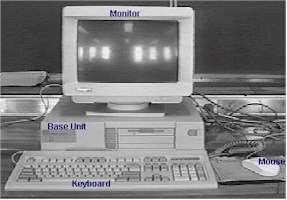
 |
Neon-komputadórComputer Users Manual, Ministry of Foreign Affairs and Cooperation, Democratic Republic of East Timor
|
|
Languages EnglishPortuguese Index IntroductionChapter I: Hardware and Software Definition of a PCCase/Chassis and Power Supply Motherboard Processor BIOS Memory Floppy Disk Drive Hard Disk Drive CD Drive Video Hardware Input/Output Ports SCSI and IDE Interface Keyboards and Mice Printers and Scanners Software Concepts Programs Systems Software Applications Software Chapter II: Networks and Communications Chapter III: Operating Systems Chapter IV: Applications Chapter V: Basic Coding and Programming Chapter VI: Basic Systems Administration Appendicies: Ministry Policy Ministry Homepage |
Definition of a PCThis first chapter provides a brief overview of a personal computer system. This will not necessarily provide the reader with much immediate knowledge, but from the experience of the author people are much more able to perform computer-related tasks if they have some idea about how the machine works as a whole. Computers are not like cars. With a car, you can be a fairly proficient driver without actually knowing much at all about car mechanics. With a computer, one can never be a proficient user without some understanding of how the hardware (the physical components) and the software (the programs) interact. Any computer training that does not take this into account provides a limited knowledge which is easily forgotten and provides no avenues for further knowledge. In other words, it's pretty useless. Unfortunately this seems to be how most so-called professional computer training companies teach. Evidently, they want you to return to services (and pay) time and time again. The end-user - that is, the people who make the most use out of this manual - will be dealing with personal computers. One definition of a personal computer is that it is any small computer system that is used by an individual, as opposed to server computers which are used by multiple people simultaneously. However, given that a networked personal computer has shared files and resources this definition isn't terribly accurate, but it certainly gives one an idea of what size of computer we are dealing with. A stricter definition exists for a type of personal computer with the abbreviation 'PC'. An Apple Macintosh is a personal computer, but chances are an Apple Macintosh user would go red with frustration if you described their computer as a 'PC'. A PC is a type of personal computer that was originally invented by IBM in 1981 and copied by numerous other manufacturers. In 1987 IBM gave up many of the original standards it established when it introduced the PS/2 range of systems. So PC computers aren't really "IBM compatible" anymore. But there are still some certain key features, such as the basic motherboard design, the floppy disk and hard disk controllers, video standards and most importantly, the Intel Central Processing Unit (CPU). In terms of hardware, the defining quality of a PC is a personal computer that uses one of the Intel 8086 families of CPUs. A further elaboration on this definition is the basic software. When IBM first developed the PC, they contracted Microsoft to write the BIOS (Basic Input/Output System) and the Disk Operating System (DOS). In what was possibly the most costly business mistake in history, IBM made this a non-exclusive contract, allowing Microsoft to sell the code to anyone else, thus providing Microsoft the ability to become the dominant software company that it is today. Microsoft is the dominant software company in terms of operating systems (the various forms of Windows) and applications (Word, Internet Explorer, Outlook). Many people describe this combination of hardware and software as a 'Wintel' system (Windows software plus Intel hardware). Under this definition, all the computers in the Ministry of Foreign Affairs are PCs. It is now opportune to explain the various hardware and software components of a PC. We can start with the system unit, the "box" that sits on the desk. Many people erroneously call this the "hard disk", but the hard disk is only one component of the system unit. Refer to the diagram below. Obviously, each and every PC will not be designed exactly as pictured below, but the components will be the same. The core components of a system unit are typically as follows:  |
Ministry of Foreign Affairs and Cooperation, GPA Building #1, Ground Floor, Dili, East Timor
Website code and design by Lev Lafayette. Last update August 20, 2003